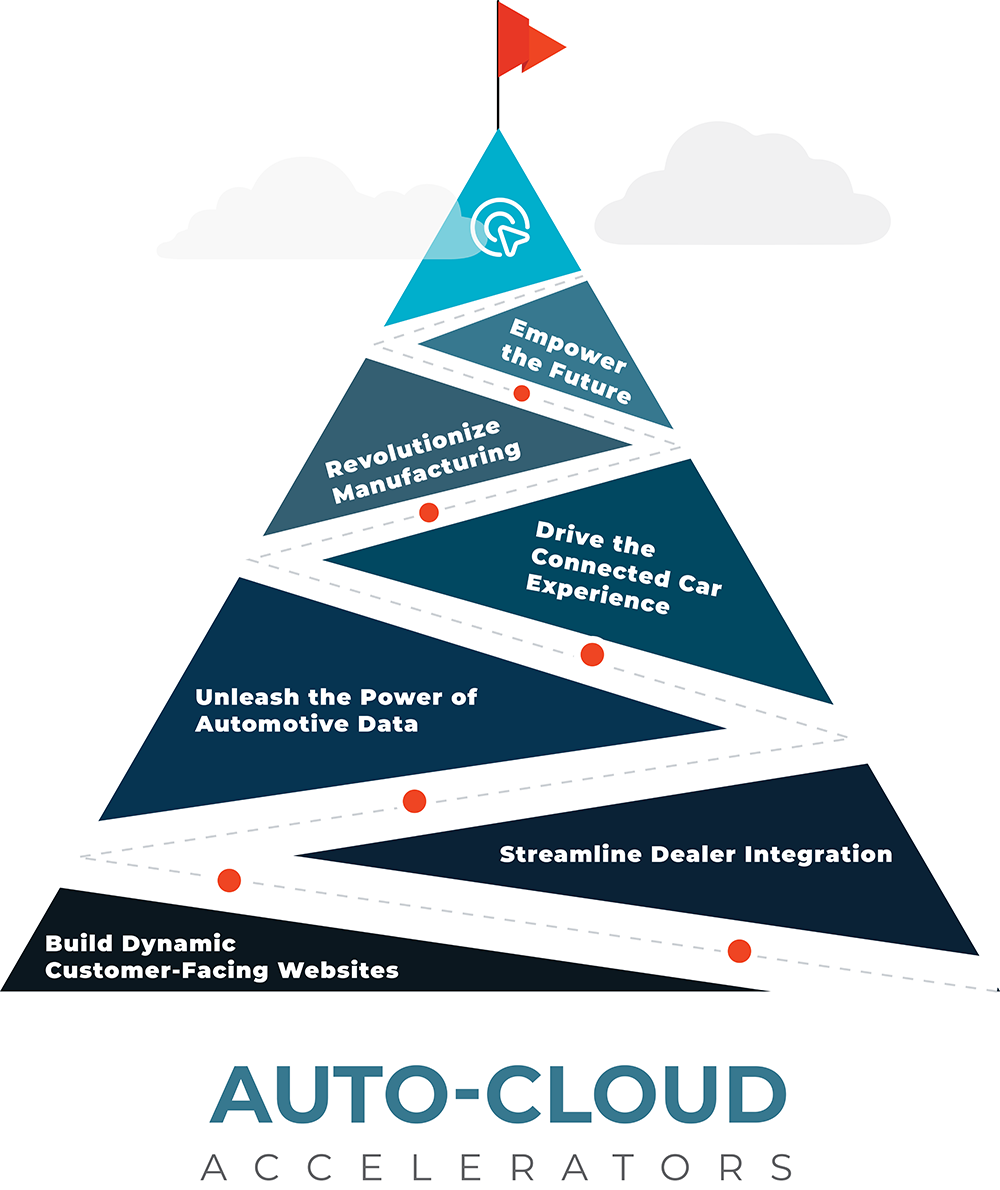The Auto Industry's Cloud Awakening
Auto manufacturers are behind the cloud adoption curve but are well-positioned to unlock the future of mobility by building foundational capabilities across six key areas.

Executing an effective cloud adoption strategy in the automotive industry is not just a way to reduce costs, increase agility, and spark innovation. It is a necessary evolutionary journey that leads to building foundational capabilities that will provide outsized returns in manufacturing and enable the connected car of tomorrow.
The automotive industry is no stranger to technological advancements. It has continuously evolved, from introducing tools to help customers find their next favorite car to developing autonomous driving. One of the latest re-emerging trends in the automotive industry is cloud adoption, which automakers have been notoriously slow to adopt but have gained momentum in recent years.
Automakers are already heavily investing in the future of driving. Cloud plays a big role in this, but there is still a wide-open ocean of opportunity moving forward:
- Volkswagen is taking an unconventional route toward self-driving car reality by building a platform containing tools needed for software creation and testing on self-driving cars - with secure processes able to scale up easily over time - taking them one step closer to the autonomous cars of tomorrow.
- GM harnessed AWS to streamline its manufacturing operations by simulating different manufacturing scenarios and anticipating potential problems before they occur - realizing a significant increase in efficiency and quality.
- Tesla is using GCP to collect and analyze car-generated data in real-time to improve self-driving car technology and create new features.
While some industries have been at the forefront of cloud adoption, realizing early and consistent benefits from the transformation, the automotive industry has notoriously lagged behind. Automakers who can accelerate their adoption in a measured and holistic way across the entire value chain will reap massive rewards.
The use of cloud platforms like AWS, Azure, and GCP has brought several advantages globally, including cutting costs, promoting flexibility, speeding up innovation, and enhancing decision-making processes using real-time data. By using these platforms, automakers can create cutting-edge workloads for customers, suppliers, dealers, and vehicles that are secure, scalable, and reliable.
In this article, we'll dive into the six core levels of cloud adoption in the auto industry and discuss the potential benefits each can bring.
The Auto-Cloud Accelerators

Car manufacturers are shortsightedly obsessed with the practical advantages of using cloud technology. You'll hear things like "I want to drive cloud adoption to reduce costs." or "We are modernizing manufacturing infrastructure to leverage data from actual site conditions."
All of this is wonderful. However, there is a huge missed opportunity when automakers don't see the connections between building a world-class cloud pipeline and platform for their customer-facing websites and the downstream connection of how that will enable the future connected car of tomorrow.
Organizations must take a more holistic approach when architecting and building cloud platforms to future-proof their organizations.
Below are six levels of cloud adoption, each building on one another, that automotive organizations must consider in order to leverage their full potential:
- Build Dynamic Customer-Facing Websites: build scalable, secure, and reliable websites that handle high traffic, provide a customized shopping experience, and offer advanced analytics capabilities.
- Streamline Dealer Integration: streamline inventory management, sales tracking, maintenance, and customer service processes while improving communication between dealerships and manufacturers.
- Unleash the Power of Automotive Data: harness data generated by vehicles, dealers, customers, and manufacturing processes to create new revenue streams, drive innovation, make better decisions, and enhance customer experiences. At a minimum, OEMs must leverage existing data that already exists.
- Drive the Connected Car Experience: provide real-time access to various services and features such as navigation, entertainment, safety, and maintenance while also enabling over-the-air updates of vehicle software and firmware.
- Revolutionize Manufacturing Capabilities: improve production efficiency by providing real-time data on production lines and equipment performance, optimizing production processes, inventory tracking, quality, human error, and reducing downtime.
- Empower the Future of Automotive Innovation: enable high-tech in-car experiences, such as autonomous driving, enhanced vehicle design, adaptive systems, and remote vehicle monitoring, while also collecting data on customer usage patterns.
Level 1: Build Dynamic Customer-Facing Websites
The foundational level of the cloud adoption journey should focus on the most well-worn path within the entire digital transformation space - customer-facing websites. Creating customer-facing websites on cloud platforms such as AWS, Azure, and GCP that provide secure and dependable applications for customer use.
Cloud platforms also enable automakers to build sites that can handle high volumes of peak-time traffic and a high degree of fault tolerance without interrupting customer experiences; additionally, they provide advanced analytics tools which provide insight into customer behaviors.
Best of all. The patterns and practices of building customer-facing websites are well-established, highly documented, and the market is full of experienced practitioners ready to provide lift to any new or in-flight project.
Key Benefits:
- Performance: provide advanced content delivery network (CDN), edge computing, and other capabilities which ensure faster website loading times.
- Security: cloud service providers invest continually in cutting-edge security technology and comply with compliance standards, giving automakers and their customer's access to safeguarded websites and data storage options.
- Scalability: adapt resources dynamically based on traffic will facilitate smooth operations during times of high demand, such as new product releases or promotional events.
Level 2: Streamline Dealer Integration
The second level of cloud adoption involves enhancing the integration between dealerships and OEMs. By leveraging cloud technology, automakers create a more seamless ‘closed-loop’ system that connects each step in the process - from inventory management to sales tracking to customer service. Cloud platforms are also able to store large amounts of data generated by dealerships and manage it in a centralized location - reducing data consistency and responsiveness issues.
Key Benefits:
- Streamlined Communication: enable secure real-time communications between manufacturers and dealerships, allowing faster responses and improved collaboration.
- Inventory Control: inventory tracking systems enable dealers to more precisely track inventory levels and vehicle shipments for improved management as well as reduced costs.
- Advanced Analytics: create tools for collecting, analyzing, and storing dealer performance information - providing greater decision-making capabilities based on hard evidence.
Level 3: Unleash the Power of Automotive Data
Automakers who adopt cloud computing gain access to massive amounts of data from vehicles, manufacturing processes, and customers. Data can be used to generate new revenue streams and further drive innovation. Manufacturers can develop productized services such as car feature and maintenance subscriptions, navigation systems connected to the internet, and predictive analytics on safety and performance.
Key Benefits:
- Data Monetization: by aggregating and analyzing anonymized data from the automotive ecosystem, as well as sharing it with other service providers such as traffic management authorities or smart city developers.
- Improved Customer Experience: provide personalized services, proactive maintenance notifications, customized insurance policies, or location-based promotions, which will improve customer satisfaction and loyalty.
- Rapid Innovation: quickly identify customer trends to more reliably develop new services and products.
Level 4: Drive the Connected Car Experience
The internet allows vehicles to be connected to devices, networks, and services. Cloud technologies are used by automakers to create an in-car interface that allows drivers and passengers real-time accessibility to services and features.
The collection and analysis of massive data from sensors and other systems of the car using cloud-based platforms helps automakers improve diving safety and support B2B fleet operations. Drivers can also be notified of potential issues with the car proactively.
Key Benefits:
- Vehicle Telematics: the collection, transmission, and analysis of live vehicle data used for monitoring vehicle health, optimizing fleet management, and providing personalized driving feedback.
- Remote Vehicle Control: like remote lock/unlock, parking locations, and climate control. Drivers can manage their cars remotely through an app on a smartphone or another connected device.
- V2X Communication: vehicle-to-everything communication enables cars to exchange data with other vehicles, infrastructure, and devices, potentially improving traffic flow, safety, and the overall driving experience.
Level 5: Revolutionize Manufacturing Capabilities
Increase production efficiency through real-time information on equipment and production lines and provide human operators with real-time feedback through augmented reality. A fully connected and modernized manufacturing implementation will help glean valuable insights, pinpoint areas for improvement, and improve downtime. Research & Development is also accelerated through modeling tools, allowing for safer, more reliable, and technologically advanced cars to be produced.
Key Benefits:
- Reduce Downtime: by scheduling maintenance in advance using cloud-based analytics.
- Effective Operations: better manage their supply chains, respond more quickly to interruptions, and maximize resources.
- Augmented Collaboration: tools allow real-time communications between employees, departments, partners, and suppliers resulting in quicker decision-making and increased production efficiency.
Level 6: Empower the Future of Automotive Innovation
The pinnacle of technological advancements within the automotive industry. Enabling customers to enjoy high-tech experiences in the car, including customized infotainment, self-driving capabilities, and remote monitoring. Cars today are looking more and more like high-tech products that come straight out of a video game or science fiction novel. In fact, they use a lot of the same technology.
At this stage, cloud platforms are so advanced and feature-rich that they are sophisticated enough to support the most complex automotive use cases, ushering in the next wave of automotive innovation at scale.
Key Benefits:
- Over-the-Air Updates: update vehicle performance and features and even fix recall issues without requiring dealership visits.
- Advanced Insights: gain valuable real-time real-world insight to improve vehicle safety and performance over time.
- Autonomous Driving: analyze and store large amounts of data produced by autonomous vehicles and support the deployment and development of fully autonomous and advanced driver-assist systems.
- AR Features: offer drivers and passengers a more immersive, interactive experience for navigation, augmented traffic data, and even create virtual dashboards that can be customized to increase driver safety and preference.
- Driver Customization: cater to each individual customer's unique preferences and needs, like voice assistants, gesture controls, biometric authentication, and customized infotainment.
Short Overview of Cloud Offerings That are Accelerating Automotive Transformation
In order to imagine what is possible, it helps to know what is already out there, ready for organizations to start using and gaining immediate benefits. Here's a brief look at five managed services AWS provides that will help automakers accelerate their cloud journey. Although other cloud providers such as Azure or GCP offer similar offerings, my goal was to focus on what AWS had available as one example and let you imagine all its possibilities:
- AWS Core IoT: provides for the secure, seamless integration between devices and AWS services - allowing automotive companies to efficiently collect, analyze, and process data collected from connected cars. The platform supports billions of messages simultaneously, allowing organizations to scale up their IoT infrastructure rapidly on demand.
- AWS Greengrass: extending AWS edge devices to enable them to act locally while still taking advantage of all of its capabilities is particularly helpful for auto manufacturers with geographically distributed production facilities; Greengrass can minimize latency and data transmission costs for faster production processes.
- Amazon SageMaker: quickly build, train, and deploy machine learning models to improve product quality, maximize production efficiencies, and predict equipment failures; additionally, it can be utilized for developing advanced driver assistance systems (ADAS) and autonomous driving capabilities.
- AWS Outposts: extend AWS services, infrastructure, APIs, and tools to any co-location facility, data center, or on-premise location - particularly beneficial for automotive industry companies who require low latency systems on-premise or local processing or storage capabilities.
- Amazon Kinesis: collect, process, and analyze streaming real-time data coming from connected cars, manufacturing equipment, and other sources in real-time.
AWS services integrate and work together to help auto manufacturers take advantage of cloud computing's power and flexibility to optimize production processes while laying the foundational future required to offer enhanced technological advancements.
Closing Thoughts
Cloud adoption within the automotive industry is a transformative journey in the middle of an ocean of opportunity providing boundless advantages. The game-changing benefits are realized by holistically designing cloud platforms to across the six levels outlined above:
- Build Dynamic Customer-Facing Websites - Start here, build your scaffolding
- Streamline Dealer Integration - Expand closer to the customer
- Unleash the Power of Automotive Data - Leverage data at scale
- Drive the Connected Car Experience - Capture and transmit useful information
- Revolutionize Manufacturing Capabilities - Improve quality and reliability
- Empower the Future of Automotive Innovation - Support foundational elements for the next generation
Automakers taking an aggressive and holistic stance towards change will better adapt to customers evolving demands, improve operations, respond to competition, and position themselves to create exceptional vehicles that push the innovation envelope of the entire industry forward.
Cloud adoption is challenging. It demands massive organizational and technological change. There is friction at almost every stage. However, automakers who embrace cloud-based technologies will remain at the forefront of this revolution while offering exceptional customer experiences and driving sustainable business growth.
How did you like this article? Your feedback helps me create better content.
Thanks for reading.
Subscribe for Free
Want to stay ahead of the curve? Subscribe now to receive the latest updates, actionable insights, and thought-provoking ideas around business, technology, and leadership straight to your inbox.



